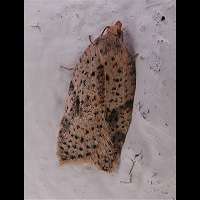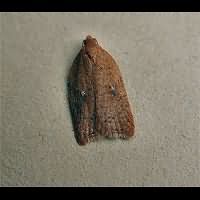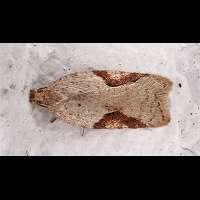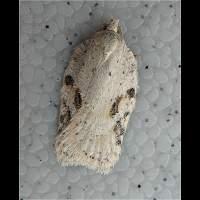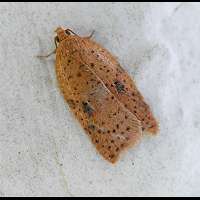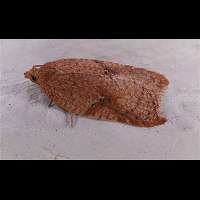Acleris notana or Acleris ferrugana, two Tortrix Moths
The reason we put two species together on this one page is that these are not only identical, but both species are also extremely variable. By just looking at them you will not be able to tell which is which. The specimen in the second picture however is likely to be Acleris notana, as Acleris ferrugana never gets that dark. The only way to tell them apart really is by examining the genitals under the microscope. In order to be able to do so, you have to kill the animal. We don't do that just for our site. Besides it won't help you much in determining which species you have found. Should you have found one of these two you either live with not knowing which it is, or you kill and dissect the animal after which you surf to specialized sites showing you the drawings of the genitals. As you can see these species maybe white, showing a dark half circle near the edge of the upperwing. They may also be brown, showing quite a dotted pattern, not seen in the white ones. In the brown specimens the circle is often lacking, but there is a dot on the place the circle usually runs. This dot may be darker than the ground colour of the wing, but in other cases it has a white center. And alas, many more variations are possible. The legs are greyish or in about the same colour as the wings and ringed. The antennae have the same colour, may be ringed but may be solid as well. Reaching a wingspan of some 14 to 18 mm both are rather small species.
Both species produce two generations a year. The autumn generation, appearing from September overwinters. The eggs are deposited in April on the host plants. The larvae fold one leaf and spin it in the folded position and lives inside. They also pupate that way. In June and July the summer generation flies about. They lay the eggs producing the autumn generation. As a result these species are present almost all year round. Acleris ferrugana however is peaking in April and October, Acleris notnana is peaking in June and August. However as the other species is still around, this is no way telling them apart. The caterpillar of Acleris notana is often said to prefer Oak, but Kuchlein mentions Birch as main host plant. Acleris ferrugana is sometimes said to prefer Birch, but in the Benelux is also found on Oak, and Beech.
Both species are fairly common all over Britain. The exact distribution is not known, due to the fact that reliable identifications are scarce. Scientific research in Holland shows that A. notana is more common than A. ferrugana, even though in our garden both are very likely to appear. Both species are quite common in Western, Northern and Central Europe.
The reason we put two species together on this one page is that these are not only identical, but both species are also extremely variable. By just looking at them you will not be able to tell which is which. The specimen in the second picture however is likely to be Acleris notana, as Acleris ferrugana never gets that dark. The only way to tell them apart really is by examining the genitals under the microscope. In order to be able to do so, you have to kill the animal. We don't do that just for our site. Besides it won't help you much in determining which species you have found. Should you have found one of these two you either live with not knowing which it is, or you kill and dissect the animal after which you surf to specialized sites showing you the drawings of the genitals. As you can see these species maybe white, showing a dark half circle near the edge of the upperwing. They may also be brown, showing quite a dotted pattern, not seen in the white ones. In the brown specimens the circle is often lacking, but there is a dot on the place the circle usually runs. This dot may be darker than the ground colour of the wing, but in other cases it has a white center. And alas, many more variations are possible. The legs are greyish or in about the same colour as the wings and ringed. The antennae have the same colour, may be ringed but may be solid as well. Reaching a wingspan of some 14 to 18 mm both are rather small species.
Both species produce two generations a year. The autumn generation, appearing from September overwinters. The eggs are deposited in April on the host plants. The larvae fold one leaf and spin it in the folded position and lives inside. They also pupate that way. In June and July the summer generation flies about. They lay the eggs producing the autumn generation. As a result these species are present almost all year round. Acleris ferrugana however is peaking in April and October, Acleris notnana is peaking in June and August. However as the other species is still around, this is no way telling them apart. The caterpillar of Acleris notana is often said to prefer Oak, but Kuchlein mentions Birch as main host plant. Acleris ferrugana is sometimes said to prefer Birch, but in the Benelux is also found on Oak, and Beech.
Both species are fairly common all over Britain. The exact distribution is not known, due to the fact that reliable identifications are scarce. Scientific research in Holland shows that A. notana is more common than A. ferrugana, even though in our garden both are very likely to appear. Both species are quite common in Western, Northern and Central Europe.

